Delay in the onset of rain – consequences and perspectives
By Artur Müller, researcher at Embrapa Cerrados
For this edition of Cultivar Máquinas magazine we prepared an operational field test, with models from the new MT7 series of LS Tractor. The two models in the series are the MT7.80F and the MT7.90F. They are two compact tractors aimed at the fruit growing market, especially dense crops such as coffee and some citrus production systems with reduced spacing.
Compact tractors are those models with reduced dimensions, compared to standard models of the same power. These are tractors that can be used in confined spaces, where maneuvering and movement are made difficult by rows of plants.
We focused our testing on understanding the cultivation restrictions and the characteristics of the MT7 series tractors in being able to carry out operations throughout the cycle, using several machines. To do this, we chose the most difficult situation, which is the coffee culture. This situation is so restrictive to the movement of machines that tractors that can move and carry out agricultural operations, in most situations, are considered special and are classified as coffee tractors. Not just any compact tractor can work in these conditions.
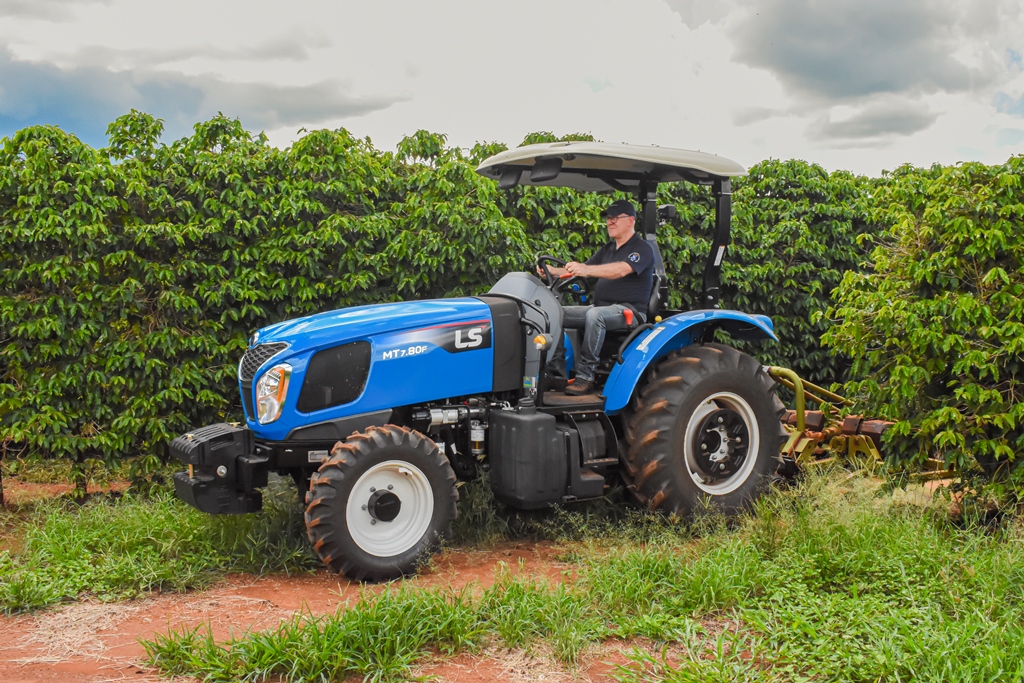
We want to take this opportunity to tell the story of the development of this project, which formed a very interesting relationship between the customer, the dealership and the manufacturer. To do this, we could not go to a more convenient location other than the Cerrado region of Minas Gerais, where we met the people who generated the idea for the project and where the first prototype of this series was born. Coffee from the Cerrado region of Minas Gerais is a designation of origin and has its characteristic flavor, more intense and strong, as opposed to coffee from other regions of the country.
The MT7 series is based on the Plus series, with the P80 and P90 models, but with characteristics aimed at the narrow tractor market with a reduced gauge.
The engine that powers the series is from Perkins, model 1104D-44, with four cylinders and 4.400 cm3, direct injection with temperature cooling by water circulation, with two valves per cylinder. This engine has been extensively developed in recent years and has low pollutant emissions, meeting the Tier 3 standard. In the MT7.80F model, the maximum power achieved is 82 hp at 2.200 rpm (SAE J1995), using a turbocharger, and the torque Maximum is 263 Nm at 1.400 rpm. In the MT7.90F model, the maximum power reached at 2.200 rpm is 95 hp (SAE J1995), but using a turbocharger combined with an intercooler, reaching a maximum torque of 393 Nm at 1.400 rpm.

In both models, the transmission is of the Synchro Shuttle type with standard factory creeper and an inverter, developing up to 20 forward and reverse speeds. The tractor we tested had a 12 x 12 transmission. The power take-off (TDP) is the one traditionally used by the LS, with three angular speeds of 540, 750 and 1.000 rpm, with economical TDP options, depending on the engine speed combination. and selector lever position. The front driving axle is from Carraro, with electro-hydraulic drive.
Very important in the combination of fruit growing machines, the hydraulic system of the new models is the same as the Plus series of category II, but with the possibility of adjusting the opening and closing of the eyes of the lower arms, with a total flow of 61,6 liters. per minute and maximum pressure of 190 bar. The remote control, equally important, has three VCR valves in the standard version with a pressure of 19 MPa and a maximum flow of 61,6 liters per minute. One of the quick-connect valves has a variable flow rate and free return, with a flow rate of two to 50 liters per minute.
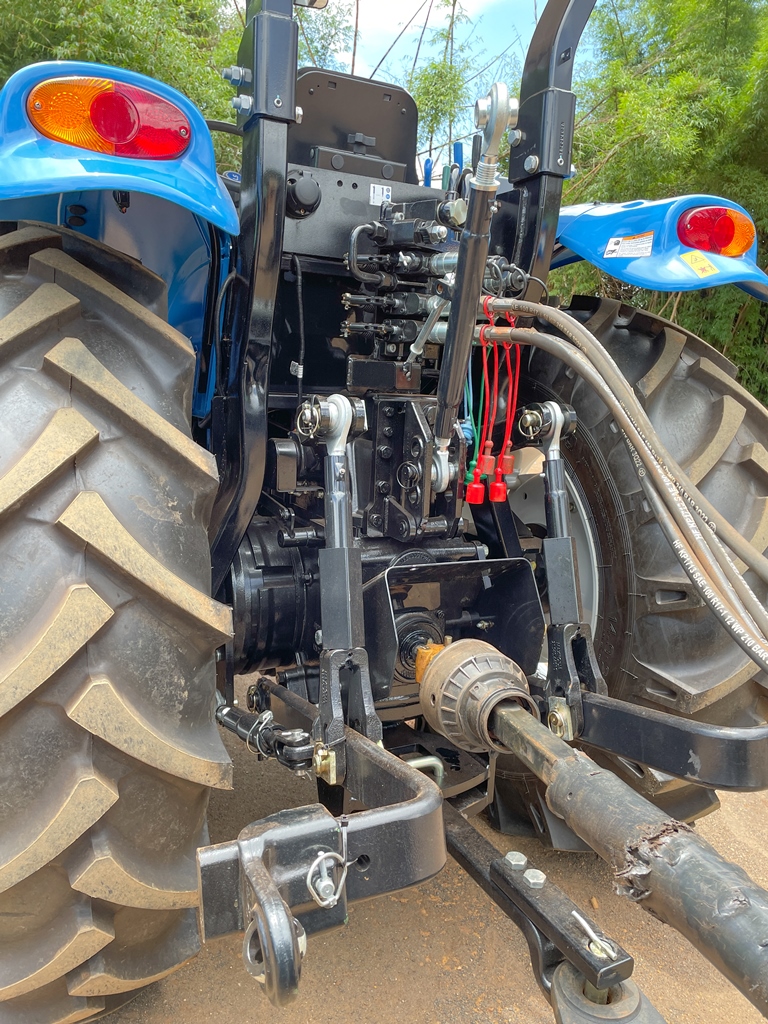
The gauge adjustment system is conventional, with flange and nuts, which in combination can give a reduced gauge tractor configuration, with a minimum of 1.090 mm on the rear wheels, up to options that are suitable for a standard agricultural tractor. In both models, the lengths of the trumpets were changed, resulting in this minimum width, with 8.0-18 tires on the front axle and 14.9-24 on the rear axle on the MT7.80F.
There is the possibility of weighting, by placing metal discs on the rear wheels and weights on a support in the front. The manufacturer also offers the possibility of placing weights under the support, to reduce the total length of the tractor and facilitate movement in confined spaces. Also, to avoid burning the coffee and reduce the possibility of the discharge hitting the coffee tree branches, the exhaust pipe was moved below the platform level, on the opposite side of the access ladder.
Viewing the two models of the MT7 series, it can be concluded that the MT7.90F model is a fruit tractor, with the possibility of adaptation for agricultural activities in general and that the MT7.80F model is typically a coffee model and perfectly adapted for work. between the rows of plants. The MT7.90F has good clearance and adapts well to other fruit crops, such as modern citrus crops with contour lines and chameleons.
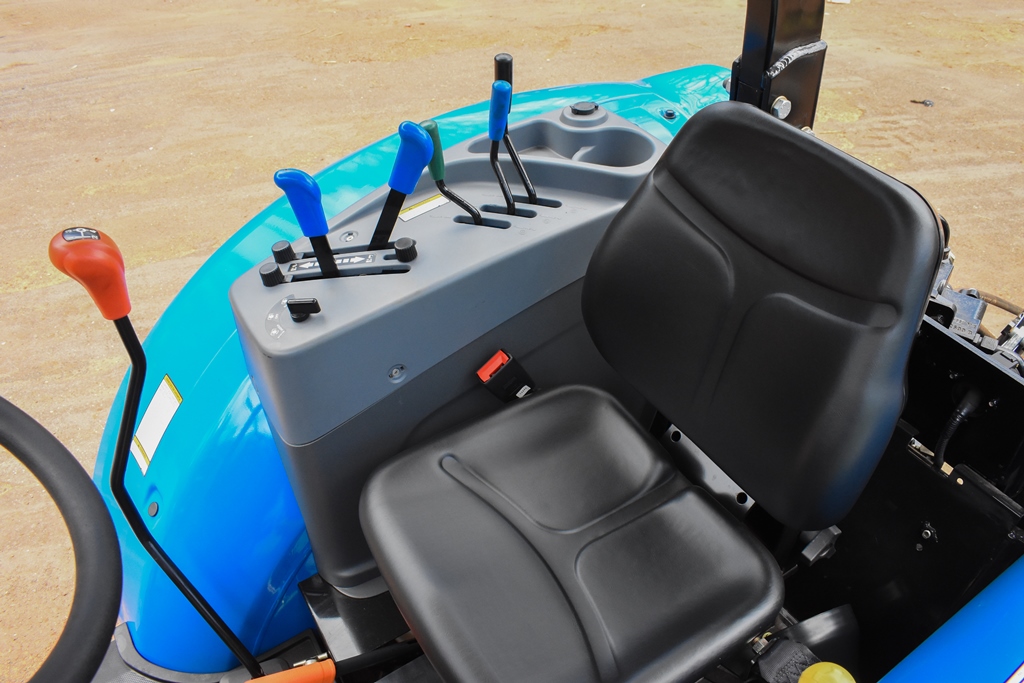
In ergonomic terms, as praised by the farm operators, we saw the tubular protectors placed on the sides of the platform as very important, which protect against the impact of branches on the operator during work.
For the test, we used a tractorized brushcutter from the Kamaq brand, model KDD F230 ECO Flex, suitable for coffee with an operational width of 2,30. During operation, we worked with varying gears and engine speeds and saw one of the qualities of this tractor, which is torque. Even at reduced revs, the engine remained stable and showed no signs of feeling the demand for power. We do not measure fuel consumption, but based on the controls carried out by the farm, this is one of the positive points, especially if there is a comparison between the amount of work carried out and the area.
We carefully evaluated the issue of increasing the air intake area for engine cooling. We also evaluated the control distribution of these models as very positive, with the inverter lever well positioned on the operator's left hand. Characteristic of the brand, the position of the gear levers, with the gear levers to the right and the three groups to the left of the operator's seat.
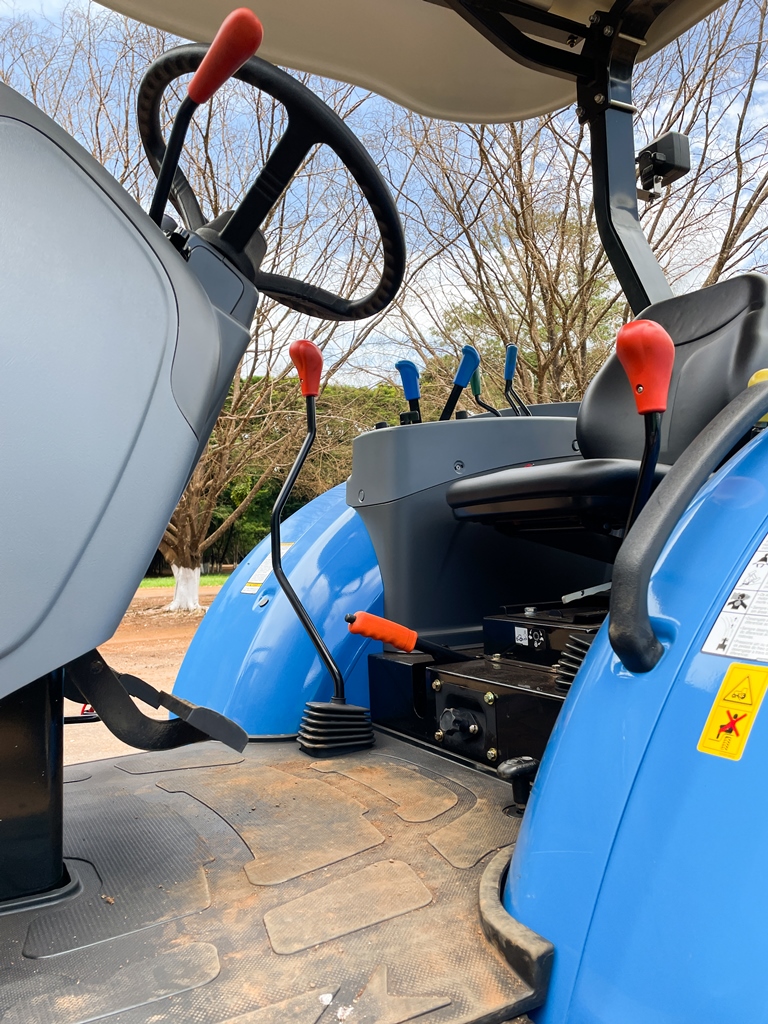
The test site for this edition was Fazenda Nossa Senhora Aparecida, which is located in the municipality of Romaria, in Alto do Paranaíba, northwest of the State of Minas Gerais, 86 km away from Uberlândia, arriving via Rodovia Deputado Camilo Machado, MG 190. This The farm has 1.380 hectares and is part of the AFB & IOB Filhos Group, based in Monte Carmelo (MG), which also has other production areas in Brazil and of which Mr. Antônio Francisquini Batista is considered the largest coffee producer in the world, with a total of 17 thousand hectares of culture.
Mr. Antônio’s story is an example of work and persistence. Born in the state of São Paulo, from a poor family he started working very early. In 1959 he started producing coffee and hasn't stopped since. In 1987 he came to Minas Gerais and faced all the frosts, many of which produced huge losses in productivity.
At the farm, we were very well received by the manager, agronomist Adriano Marques Azer, who provided us with conditions to carry out the test and told us many interesting things about coffee production in the Minas Gerais cerrado. Managing 49 people, including 18 tractor drivers and with 28 coffee tractors and two agricultural tractors on this farm, they believe that mechanization is the only way out for coffee farming, which suffers year after year from frost, leafminers and competition. other crops with greater profitability per area, such as soybeans, for example. A coffee plantation that is cut down due to frost is rarely replaced.
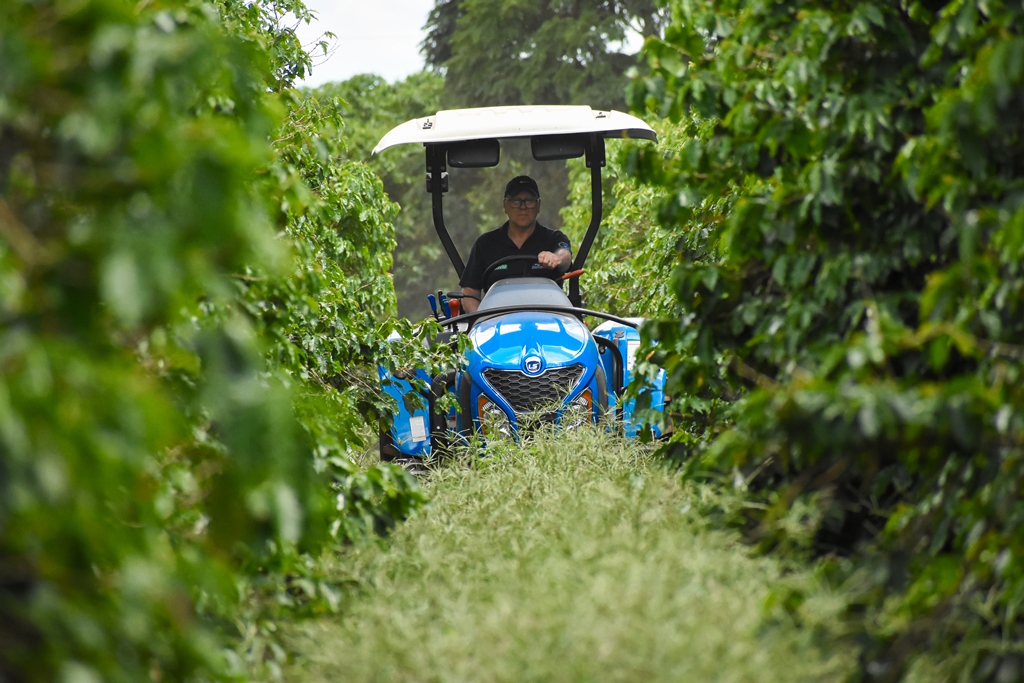
And in recent years, coffee farming in the Minas Gerais cerrado has suffered a series of climate-related problems. In the 2020/21 harvest it was frost, combined with little rain during the cycle. In 2021/22, oddly enough, it was the excess rain that harmed production and, in 2022/23, the villain was the extreme heat, which significantly reduced the harvest. After three years of suffering from problems and much lower production than expected, this year, so far, looks very encouraging.
Coffee is a semi-permanent crop, with a lot of operational activity during the cycle. The first harvest begins at two and a half years old and the plants are kept in the field for around 30 years, when they are then renewed. During the harvest, which is carried out between May and September, a biannual fluctuation in productivity is natural, which on average in the rainfed area is 29 bags per hectare. Harvesting is done with a machine pulled by the tractor, but with a motor to drive the vibrators. The harvested coffee is temporarily stored in the machine and then unloaded. During the vibration of the branches, a small part of the production falls to the ground and is first swept close to the trunk and then collected from the ground by machines that vacuum up the coffee. This portion resulting from stripping is collected and placed separately from the coffee harvested by the machine.
Engineer Adriano explained to us that, due to the lack of labor, mechanization has advanced a lot in recent years and requires special equipment, including a powerful tractor, but narrow enough not to damage the crop and harm production, as contact physique of the machine with the branches drops the coffee.
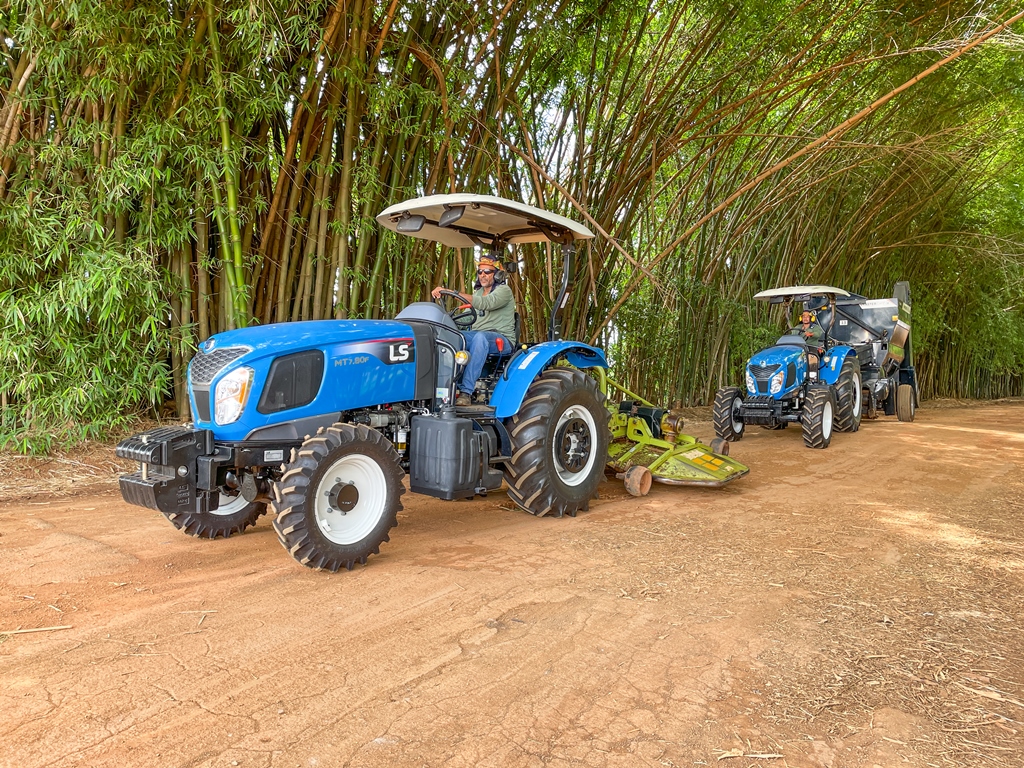
Now, at Fazenda Nossa Senhora Aparecida, the coffee crop is in the growth phase, in a stage they call chumbinho, and it is time to reinforce plant nutrition and control of invasives, done through mowing. The months of November and December are a lot of work for the sprayer, who makes applications to control the main problem in coffee, which is the leaf miner (Leucoptera coffeella).
Currently, the farm has three LS model U60 tractors and received the two MT7s for testing and verification of operation. From an evaluation of the tractors being used, the team finds the tractor to be very good, with a lot of power, and highlights the ease of maneuvering and low fuel consumption. Regarding the new MT series models, he considers that, despite having a larger engine, consumption per area is better. As an advantage, it also highlights the comfort of the operator's position, the suitability of the controls' position and the presence of the reverser, which for them is vital in operations.
The company aims to further improve the comfort and safety of operators and, therefore, in the future wants 100% of the fleet to have a cabin. For them, the size of the MT series tractors is adequate for the operations in the spacing system they use.
This new series of tractors will certainly place LS Tractor among the manufacturers with the best model options for working in dense crops, such as coffee, oranges and other crops with reduced spacing. In addition to being the impression we were left with at the end of the test, it was the feeling expressed by the customer who had already had the opportunity to use the MT7.80F and MT7.90F models in the coffee culture.

Olimáquinas, the LS concessionaire, is a company of the Lidon Group, headquartered in Patrocínio (MG) and which, in addition to the LS concession, has other companies and operates in the field of agricultural production. In 1985, Olidon Carlos da Silva and his wife Maria Aparecida da Silva founded the company and, from then on, the family succession continued with the work of their sons Desio, Cassio and Juliano Silva, who is currently the company's CEO.
It is a family business that was born from coffee production, as Mr. Odilon was born in the region and considered the first coffee producer in the cerrado. His son Olidon started out as an agricultural mechanic when he was 23 years old, and from then on he only developed his passion for creating and adapting machines to the true needs of the producer.
Since 2013 as a dealership for the LS brand, the company has been considered the national sales leader and has its main store in Patrocínio (MG) and branch stores in Sete Lagoas, Uberlândia, Patos, São Sebastião do Paraíso, Franca and Catanduva and now starting a operation in the State of Goiás.

Anyone will be impressed by Mr. Olidon's enthusiasm telling the story of his family and especially his role in creating and developing the prototype of this tractor for the coffee shop. Savoring a splendid local coffee, we listened attentively to the story told by a man with simple manners, but notably intelligent and hardworking.
He told us that the LS portfolio had tractors with dimensions appropriate for working in the cafe, such as the U60, but it still did not have larger tractors available, in the 80 hp and 90 hp range, with reduced dimensions, for heavier tasks, such as pulling coffee harvesters and collectors.
He explained that it took six years between the beginning and completion of the coffee tractor project, which was born from the Plus 80 model, on sale at the time and today. A tractor with reduced dimensions was needed, but with power in the range of 80 hp.
The initial forecast was to complete the project in three years, a period that was prolonged due to the pandemic, which paralyzed the project between 2021 and 2022, but in 2023, with the end of restrictions and the market returning to normal, the prototype was completed and presented to the company.
He was full of praise for LS, which responded to a customer request and agreed to do a joint project through the dealership. He said that he had had previous experiences and that the response from another manufacturer had been negative. With LS there was reception and exchange of information and the project progressed and had the desired effect. The prototype was assembled at the dealership in 100 days of work and field tests lasted another year.
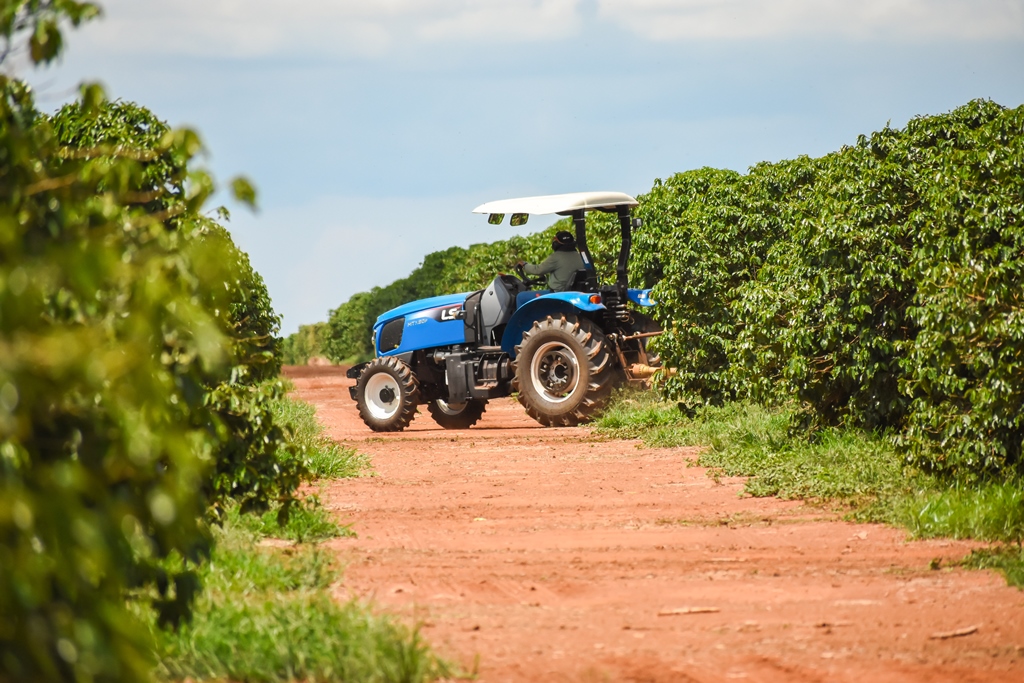
The focus was to develop a version of a coffee tractor with 80 hp to 90 hp and make adaptations to the Plus 80 to reduce dimensions and facilitate movement, even with large machines attached to the tractor. And the conditions were not the most favorable, as coffee, in general, uses row spacing of four meters, but there are producers who use 3,8 meters. The most severe tasks are pulling the coffee collector and high-demand brushes, and for this purpose, the power of the Plus 80 was enough. Therefore, the adaptation work was mainly aimed at reducing dimensions. To achieve this, the trumpets and axle shafts were redesigned, reducing their length. In the driver's seat, the height of the steering wheel was modified and the positions of the control levers and the operator's seat were changed. The hydraulic system was also modified with the addition of a higher-flow hydraulic pump and four remote control valves (VCRs), with one having a continuous flow.
A Carraro brand front axle was placed in the auxiliary traction, with the aim of reducing the turning radius and facilitating maneuvers. The exhaust outlet was changed to avoid impacting the plants and to avoid burning the branches of the coffee tree, especially when the tractor moves at low speeds.
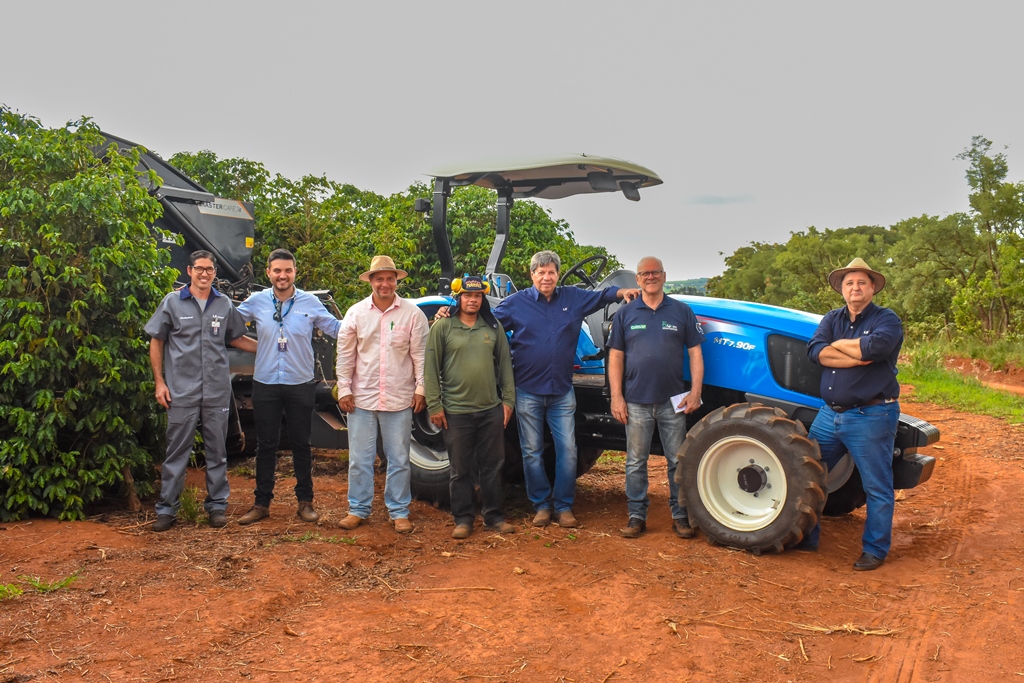
Some details were preserved to ensure that MT7 was not restricted to coffee and could be used in other crops. For example, the gauge opening and closing system was protected, potentially increasing the width of the tractor.
Asked if the experience was positive, Mr Olidon was very satisfied and said that the prototype continues to work on the family farm. He explained, based on his knowledge, that the workforce is decreasing in the field and especially in the harvesting operation. Coffee requires more and more machines and more work, and this tractor profile, with power between 80 hp and 90 hp, is the one that most favors the producer, as there is a line of compatible machines and implements being offered on the market. A powerful tractor with smaller dimensions is required. But we also cannot forget the comfort of the operator, who often works long hours and needs safety and ergonomic controls.

Receive the latest agriculture news by email